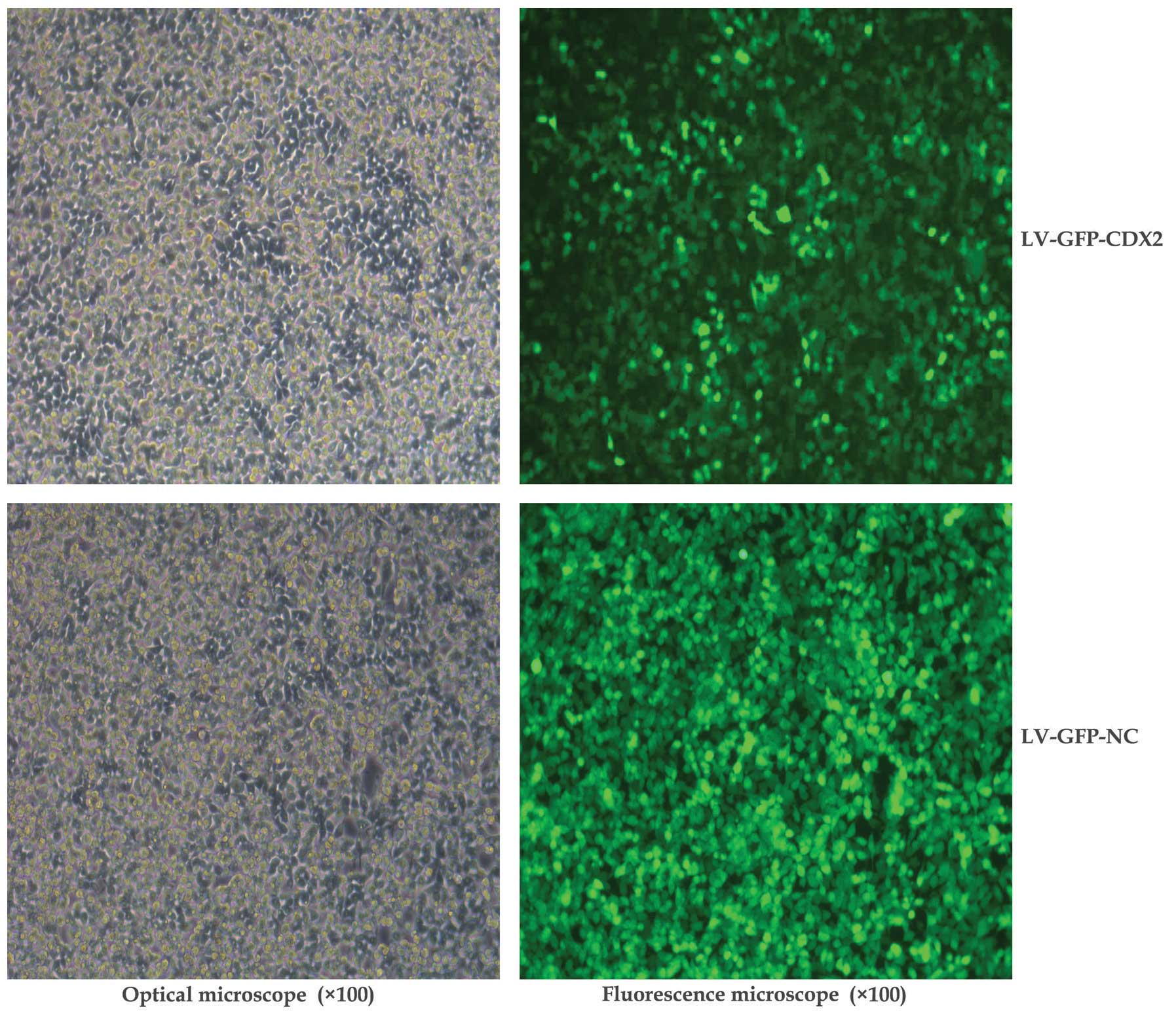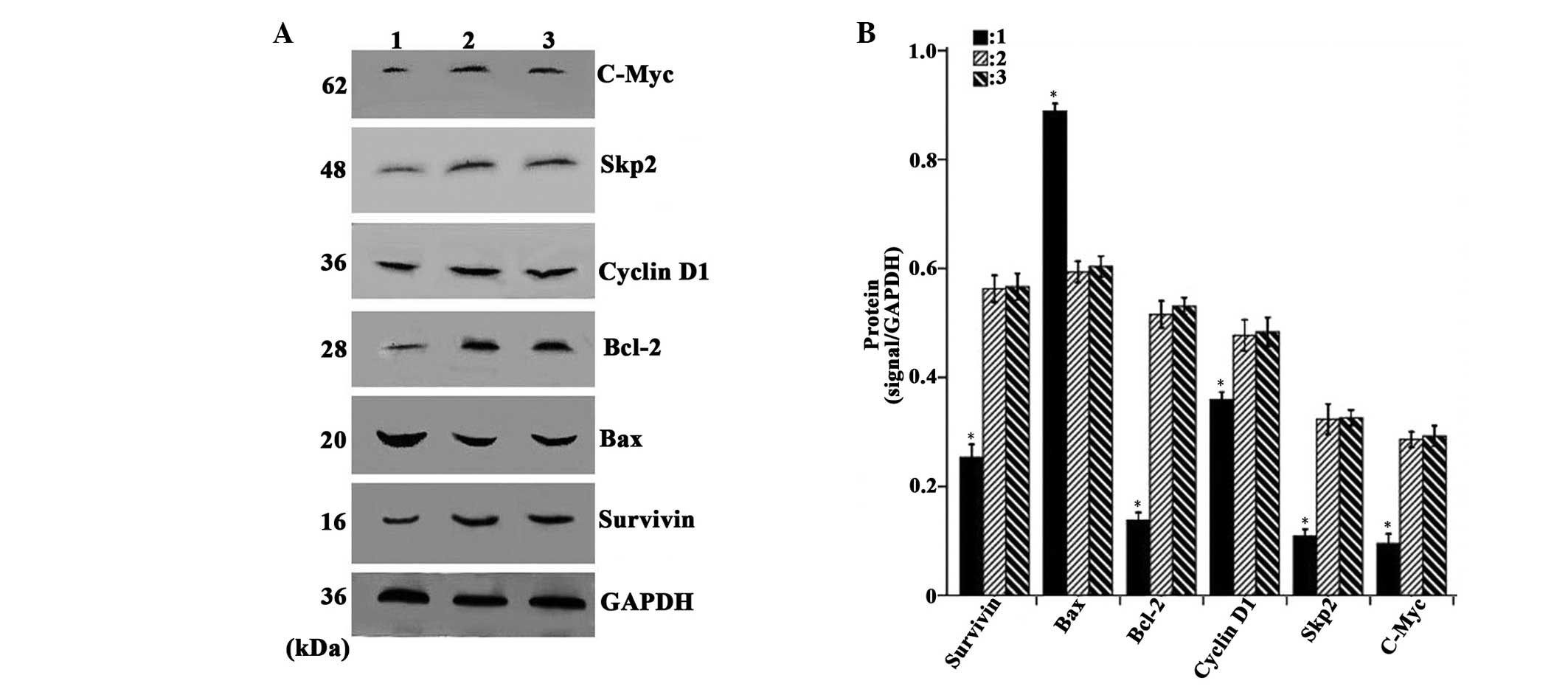|
1
|
Chong VH, Telisinghe PU, Abdullah MS and
Chong CF: Gastric cancer in Brunei Darussalam: epidemiological
trend over a 27 year period (1986–2012). Asian Pac J Cancer Prev.
15:7281–7285. 2014. View Article : Google Scholar
|
|
2
|
Orditura M, Galizia G, Sforza V, et al:
Treatment of gastric cancer. World J Gastroenterol. 20:1635–1649.
2014. View Article : Google Scholar : PubMed/NCBI
|
|
3
|
Duprey P, Chowdhury K, Dressler GR,
Balling R, Simon D, Guenet JL and Gruss P: A mouse gene homologous
to the Drosophila gene caudal is expressed in epithelial cells from
the embryonic intestine. Genes Dev. 2(12A): 1647–1654. 1988.
View Article : Google Scholar : PubMed/NCBI
|
|
4
|
Drummond F, Putt W, Fox M and Edwards YH:
Cloning and chromosome assignment of the human CDX2 gene. Ann Hum
Genet. 61:393–400. 1997. View Article : Google Scholar
|
|
5
|
Yuasa Y: Control of gut differentiation
and intestinal-type gastric carcinogenesis. Nat Rev Cancer.
3:592–600. 2003. View
Article : Google Scholar : PubMed/NCBI
|
|
6
|
Bai YQ, Yamamoto H, Akiyama Y, et al:
Ectopic expression of homeodomain protein CDX2 in intestinal
metaplasia and carcinomas of the stomach. Cancer Lett. 176:47–55.
2002. View Article : Google Scholar : PubMed/NCBI
|
|
7
|
Xiao ZY, Ru Y, Sun JT, Gao SG, Wang YF,
Wang LD and Feng XS: Expression of CDX2 and villin in gastric
cardiac intestinal metaplasia and the relation with gastric cardiac
carcinogenesis. Asian Pac J Cancer Prev. 13:247–250. 2012.
View Article : Google Scholar : PubMed/NCBI
|
|
8
|
Qin R, Wang NN, Chu J and Wang X:
Expression and significance of homeodomain protein Cdx2 in gastric
carcinoma and precancerous lesions. World J Gastroenterol.
18:3296–3302. 2012.PubMed/NCBI
|
|
9
|
Kang JM, Lee BH, Kim N, Lee HS, Lee HE,
Park JH, Kim JS, Jung HC and Song IS: CDX1 and CDX2 expression in
intestinal metaplasia, dysplasia and gastric cancer. J Korean Med
Sci. 26:647–653. 2011. View Article : Google Scholar : PubMed/NCBI
|
|
10
|
Zhang JF, Zhang JG, Kuai XL, Zhang H,
Jiang W, Ding WF, Li ZL, Zhu HJ and Mao ZB: Reactivation of the
homeotic tumor suppressor gene CDX2 by
5-aza-2′-deoxycytidine-induced demethylation inhibits cell
proliferation and induces caspase-independent apoptosis in gastric
cancer cells. Exp Ther Med. 5:735–741. 2013.PubMed/NCBI
|
|
11
|
Xie Y, Li L, Wang X, Qin Y, Qian Q, Yuan X
and Xiao Q: Overexpression of Cdx2 inhibits progression of gastric
cancer in vitro. Int J Oncol. 36:509–516. 2010.PubMed/NCBI
|
|
12
|
Li QL, Yang ZL, Liu JQ and Miao XY:
Expression of CDX2 and hepatocyte antigen in benign and malignant
lesions of gallbladder and its correlation with histopathologic
type and clinical outcome. Pathol Oncol Res. 17:561–568. 2011.
View Article : Google Scholar : PubMed/NCBI
|
|
13
|
Ikarashi S, Nishikura K, Ajioka Y and
Aoyagi Y: Re-evaluation of phenotypic expression in
undifferentiated-type early gastric adenocarcinomas using mucin
core protein and CDX2. Gastric Cancer. 16:208–219. 2013. View Article : Google Scholar
|
|
14
|
Gross I, Duluc I, Benameur T, Calon A,
Martin E, Brabletz T, Kedinger M, Domon-Dell C and Freund JN: The
intestine-specific homeobox gene Cdx2 decreases mobility and
antagonizes dissemination of colon cancer cells. Oncogene.
27:107–115. 2008. View Article : Google Scholar
|
|
15
|
Park Y, Srivastava A, Kim GH,
Mino-Kenudson M, Deshpande V, Zukerberg LR, Song GA and Lauwers GY:
CDX2 expression in the intestinal-type gastric epithelial
neoplasia: Frequency and significance. Mod Pathol. 23:54–61. 2010.
View Article : Google Scholar
|
|
16
|
Chang YT, Hsu C, Jeng YM, Chang MC, Wei SC
and Wong JM: Expression of the caudal-type homeodomain
transcription factor CDX2 is related to clinical outcome in biliary
tract carcinoma. J Gastroenterol Hepatol. 22:389–394. 2007.
View Article : Google Scholar : PubMed/NCBI
|
|
17
|
Huang LP, Yu YH, Sheng C and Wang SH:
Up-regulation of cadherin 17 and down-regulation of homeodomain
protein CDX2 correlate with tumor progression and unfavorable
prognosis in epithelial ovarian cancer. Int J Gynecol Cancer.
22:1170–1176. 2012. View Article : Google Scholar : PubMed/NCBI
|
|
18
|
Wang XT, Wei WY, Kong FB, Lian C, Luo W,
Xiao Q and Xie YB: Prognostic significance of Cdx2
immunohistochemical expression in gastric cancer: A meta-analysis
of published literatures. J Exp Clin Cancer Res. 31:982012.
View Article : Google Scholar : PubMed/NCBI
|
|
19
|
Shirali S, Aghaei M, Shabani M, Fathi M,
Sohrabi M and Moeinifard M: Adenosine induces cell cycle arrest and
apoptosis via cyclinD1/Cdk4 and Bcl-2/Bax pathways in human ovarian
cancer cell line OVCAR-3. Tumour Biol. 34:1085–1095. 2013.
View Article : Google Scholar : PubMed/NCBI
|
|
20
|
Tian YF, Chen TJ, Lin CY, et al: SKP2
overexpression is associated with a poor prognosis of rectal cancer
treated with chemoradio-therapy and represents a therapeutic target
with high potential. Tumour Biol. 34:1107–1117. 2013. View Article : Google Scholar : PubMed/NCBI
|
|
21
|
Zhang X, Bi L, Ye Y and Chen J:
Formononetin induces apoptosis in PC-3 prostate cancer cells
through enhancing the Bax/Bcl-2 ratios and regulating the p38/Akt
pathway. Nutr Cancer. 66:656–661. 2014. View Article : Google Scholar : PubMed/NCBI
|
|
22
|
Liu X, Yu H, Cai H and Wang Y: Expression
of CD24, p21, p53, and c-myc in alpha-fetoprotein-producing gastric
cancer: Correlation with clinicopathologic characteristics and
survival. J Surg Oncol. 109:859–864. 2014. View Article : Google Scholar : PubMed/NCBI
|
|
23
|
Takahashi K, Hirano F, Matsumoto K, Aso K
and Haneda M: Homeobox gene CDX2 inhibits human pancreatic cancer
cell proliferation by down-regulating cyclin D1 transcriptional
activity. Pancreas. 38:49–57. 2009. View Article : Google Scholar
|
|
24
|
Yang Z, Li C, Wang X, et al: Dauricine
induces apoptosis, inhibits proliferation and invasion through
inhibiting NF-kappaB signaling pathway in colon cancer cells. J
Cell Physiol. 225:266–275. 2010. View Article : Google Scholar : PubMed/NCBI
|
|
25
|
Saha A, Blando J, Silver E, Beltran L,
Sessler J and Digiovanni J: 6-Shogaol from dried ginger inhibits
growth of prostate cancer cells both in vitro and in vivo through
inhibition of STAT3 and NF-kappaB Signaling. Cancer Prev Res
(Phila). 7:6272014. View Article : Google Scholar
|
|
26
|
Barré B and Perkins ND: A cell cycle
regulatory network controlling NF-kappaB subunit activity and
function. EMBO J. 26:4841–4855. 2007. View Article : Google Scholar : PubMed/NCBI
|
|
27
|
Kannaiyan R, Hay HS, Rajendran P, et al:
Celastrol inhibits proliferation and induces chemosensitization
through down-regulation of NF-κB and STAT3 regulated gene products
in multiple myeloma cells. Br J Pharmacol. 164:1506–1521. 2011.
View Article : Google Scholar : PubMed/NCBI
|
|
28
|
Barrezueta LF, Oshima CT, Lima FO, De
Oliveira Costa H, Gomes TS, Neto RA and De Franco MF: The intrinsic
apoptotic signaling pathway in gastric adenocarcinomas of Brazilian
patients: Immunoexpression of the Bcl-2 family (Bcl-2, Bcl-x, Bak,
Bax, Bad) determined by tissue microarray analysis. Mol Med Rep.
3:261–267. 2010. View Article : Google Scholar
|
|
29
|
Roset R, Ortet L and Gil-Gomez G: Role of
Bcl-2 family members on apoptosis: What we have learned from
knock-out mice. Front Biosci. 12:4722–4730. 2007. View Article : Google Scholar : PubMed/NCBI
|
|
30
|
Jiang H, Zhao PJ, Su D, Feng J and Ma SL:
Paris saponin I induces apoptosis via increasing the Bax/Bcl-2
ratio and caspase-3 expression in gefitinib-resistant non-small
cell lung cancer in vitro and in vivo. Mol Med Rep. 9:2265–2272.
2014.PubMed/NCBI
|
|
31
|
Kuo HC, Kuo WH, Lee YJ, Lin WL, Chou FP
and Tseng TH: Inhibitory effect of caffeic acid phenethyl ester on
the growth of C6 glioma cells in vitro and in vivo. Cancer Lett.
234:199–208. 2006. View Article : Google Scholar
|
|
32
|
Leu WJ, Chang HS, Chan SH, Hsu JL, Yu CC,
Hsu LC, Chen IS and Guh JH: Reevesioside A, a cardenolide
glycoside, induces anticancer activity against human
hormone-refractory prostate cancers through suppression of c-myc
expression and induction of G1 arrest of the cell cycle. PLoS ONE.
9:e873232014. View Article : Google Scholar : PubMed/NCBI
|
|
33
|
Castagnino P, Kothapalli D, Hawthorne EA,
Liu SL, Xu T, Rao S, Yung Y and Assoian RK: miR-221/222 compensates
for Skp2-mediated p27 degradation and is a primary target of cell
cycle regulation by prostacyclin and cAMP. PLoS ONE. 8:e561402013.
View Article : Google Scholar : PubMed/NCBI
|
|
34
|
Osawa T, Atsumi Y, Sugihara E, Saya H,
Kanno M, Tashiro F, Masutani M and Yoshioka K: Arf and p53 act as
guardians of a quiescent cellular state by protecting against
immortalization of cells with stable genomes. Biochem Biophys Res
Commun. 432:34–39. 2013. View Article : Google Scholar : PubMed/NCBI
|
|
35
|
Choi JK, Kim KH, Park SR and Choi BH:
Granulocyte macrophage colony-stimulating factor shows
anti-apoptotic activity via the PI3K-NF-κB-HIF-1α-survivin pathway
in mouse neural progenitor cells. Mol Neurobiol. 49:724–733. 2014.
View Article : Google Scholar
|
|
36
|
Lee KH, Choi EY, Koh SA, et al:
Down-regulation of survivin suppresses uroplasminogen activator
through transcription factor JunB. Exp Mol Med. 43:501–509. 2011.
View Article : Google Scholar : PubMed/NCBI
|
|
37
|
Szafer-Glusman E, Fuller MT and Giansanti
MG: Role of Survivin in cytokinesis revealed by a
separation-of-function allele. Mol Biol Cell. 22:3779–3790. 2011.
View Article : Google Scholar : PubMed/NCBI
|
|
38
|
Götz J, David D, Hoerndli F, et al:
Functional genomics dissects pathomechanisms in tauopathies:
Mitosis failure and unfolded protein response. Neurodegener Dis.
5:179–181. 2008. View Article : Google Scholar : PubMed/NCBI
|















